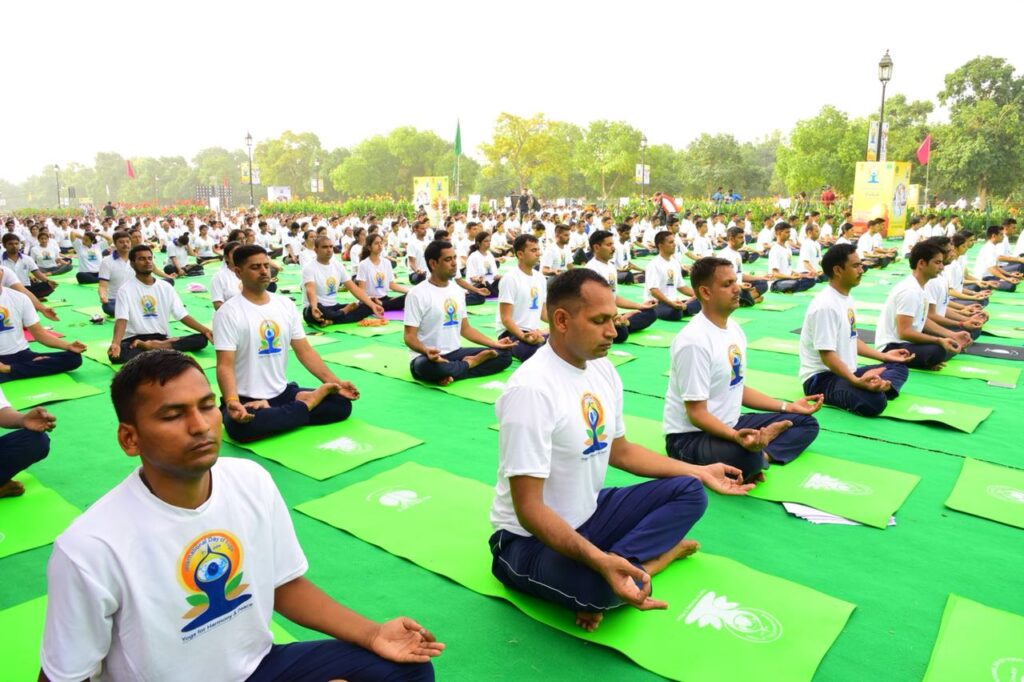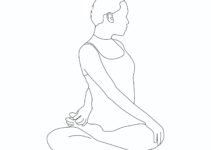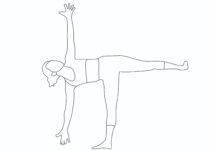What is the meaning of Kapalbhati?
‘Kapala’ means skull (head), and ‘Bhati’ means to shine. Because this practice makes the crown shine, therefore it is called Kapalbhati. In other words, it rejuvenates the head region and the mental functions. In the Gheraṇḍasaṁhita, it is known as Bhalabhati; Bhala and Kapala means the ‘cranium’ or forehead. Bhati is ‘light’ or ‘splendour’; it also means ‘perception and knowledge’. It is also known as Frontal brain cleansing yogic practice.
Kapalbhati is one of the pre-requisites of Pranayama. It invigorates the entire brain and awakens the dormant centres which are responsible for subtle perception. In Kapalbhati, breathing is done like the pumping action of a pair of bellows. Inhalation is passive and spontaneous, and exhalation is with force.

Difference between Kapalbhati and Bhastrika pranayama
Kapalbhati is similar to Bhastrika praṇayama. The difference between the two is only that in Bhastrika a practitioner uses force on both inhalation and exhalation, expanding and contracting the lungs; while in Kapalbhati inhalation is automatic and passive, and it occurs as a result of forced exhalation. Kapalbhati actively reduces the volume of air in the lungs through forced exhalation. In Haṭhapradīpika, Kapalbhati has been described as follows:
“Perform exhalation and inhalation rapidly like a bellows (of a blacksmith). This is Kapalabati which destroys all mucus disorders”.
How to do Kapalbhati step-by-step
- Sit in a meditative posture, eyes closed and the whole body relaxed.
- Inhale deeply through both nostrils, expanding the abdomen, and exhale with a forceful contraction of the abdominal muscles.
- The next inhalation occurs passively, allowing the abdominal muscles to expand. Inhalation should be spontaneous or passive without effort.
- The breathing must be of the bellows’ type.
- Repeat this exercise rapidly several times. While doing this exercise, the abdomen should distend and contract.
Breathing in Kapalbhati
There should be rapid breathing to start the practice with emphasis on exhalation. Inhale
deeply once. Exhale deeply once. Retain breath during maha bandha. Inhale after releasing Maha Bandha. Normal breathing, if necessary, before commencing the next round. Breathe
through your nose throughout the practice; do not breathe through your mouth. After completing the maha bandha, you may find it a little challenging to live in. It is as though the lungs become locked. This problem can be overcome by exhaling very slightly immediately before inhalation. Remember, the rapid breathing should be from the abdomen and not from the chest.
Eight wonder benefits of Kapalbhati
- Kapalbhati clears the respiratory passage and keeps it free from impurities and excess mucus.
- It is useful in treating colds, rhinitis (inflammation of the mucus membrane of the nose), sinusitis and bronchial infections.
- It stimulates nerves in the abdominal region, massages abdominal organs, and improves digestion.
- It increases the capacity of the lungs.
- Kapalbhati clears the respiratory passage and keeps it free from impurities and excess mucus.
- It is useful in treating colds, rhinitis (inflammation of the mucus membrane of the nose), sinusitis and bronchial infections.
- It stimulates nerves in the abdominal region, massages abdominal organs, and improves digestion.
- It increases the capacity of the lungs.
Scientific Explanation of Kapalbhati
Kapalbhati and Bhastrika are essentially the techniques of vigorous respiration and thus combine the advantage of increased oxygen intake and aeration and drying of the respiratory passages. In Bhastrika, there is no emphasis on Kumbhaka or the holding of the breath. Specific studies on the physiological effects of various types of respiratory exercises on oxygen consumption demonstrated appreciable differences in oxygen consumption. Bhastrika has been found to cause an increase in oxygen consumption to the extent of 18.5 %; thus, the vitalizing influence of Kapalbhati is quite evident.
In Kapalbhati, prolonged and forced exhalation is beneficial for the brain. Andre van Lysebeth (as quoted in Hatha Yoga Pradipika by Swami Muktibodhananda, 2000) discusses the mechanical influence of the respiratory cycle on the brain’s structure. During normal inhalation, cerebrospinal fluid around the brain gets compressed; as a result, the brain contracts very slightly during normal breathing. During normal exhalation, this fluid is decompressed resulting in slight brain expansion. The forced and prolonged exhalation in Kapalbhati increases the decompression of the liquid and development of the brain and enhances the massaging effect on the brain.
Kapalbhati precautions
- It should be done before meditational practices and after Yogasanas and Cleansing yogic practices.
- Inhalation should be spontaneous, i.e. without effort, and the exhalation should be with force, but at the same time, it should not make the person feel breathless.
- This practice should be avoided by the person suffering from cardiac conditions, giddiness, high blood pressure, vertigo, epilepsy, stroke, hernia and gastric ulcers.
Types of kapalbhati
Gheraṇḍasaṁhita describes the following three kinds of Kapalbhati:
- VatakramaKapalbhati (air cleansing breathing)
- VyutkramaKapalbhati (reversed/sinus cleansing breathing)
- ŚītkramaKapalbhati (cooling/mucous cleansing breathing )
Vatakrama Kapalbhati (Air Cleansing Breathing)
One should draw in air through Iḍa/ Candra (the left nostril) and expel it out through Piṅgla / Surya (the right nostril). Again, drawing air through the Piṅgla, one should expel it through the Candra (left nostril). After rapidly inhaling and exhaling, one should not hold the breath.
Benefits
- It wards off disorders of phlegm.
- It strengthens the respiratory system.
Vyutkrama Kapalbhati (Reversed/Sinus Cleansing Breathing)
Prepare lukewarm salty water (ratio 1 tsp salt: ½ litre water); relax the body; snort the water into the nostrils, letting it flow down into the mouth; repeat several times. Perform Bhastrika as described in the case of Jalaneti. It gives the same benefits as Jalneti
Sitkrama Kapalbhati (Cooling/ Mucus Cleansing Breathing)
Prepare lukewarm salty water as above. Take the water into the mouth and push it up, expelling it through the nose; repeat several times. Perform Bhastrika. Benefits are similar to Jalaneti, but more intensified with more stimulation to the facial nerves.






Kaphalbati explained in best way that I have got ever over the internet.